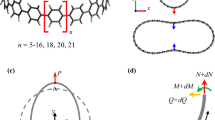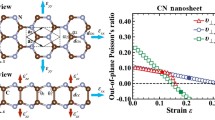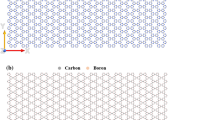Abstract
The intrinsic negative Poisson’s ratio effect at the level of molecule in two-dimensional nanomaterials, especially in the perfect planar nanostructures with a single atom thickness, is really rare and has attracted a lot of research interests because of its unique mechanical properties in the nanoscale and extensive applications in mechanical nanodevices. In this work, a novel ideal planar carbon nanostructure (PCNS) framework with a single atom thickness composed by carbon and hydrogen atoms is proposed and studied by means of first-principles density functional calculation. The results showed that the PCNS is, simultaneously, of excellent thermodynamic, molecular dynamic and mechanical stabilities. In addition, the electronic structure, mechanical characters, and optical-electronic characteristics of PCNS are also explored. Excitedly, it is found that the PCNS has a significant negative Poisson's ratio effect in plane, and the maximum value of Poisson's ratio is as high as − 2.094. Meanwhile, the material has a wide range of elastic mechanics. Moreover, the PCNS presents an ideal UV absorption performance. It is hoped that this work could be a useful structural design strategy for the development of the ideal 2D carbon-based nanomechanical devices with the intrinsic negative Poisson’s ratio effect and other electronic functions.
Graphic abstract
An ideal 2D carbon nanostructure with negative Poisson's ratio was designed and its properties were investigated from first principles calculation.









Similar content being viewed by others
References
Jiang JW, Park HS (2014) Negative Poisson’s ratio in single-layer black phosphorus. Nat Commun 5:4727–4733
Kou LZ, Chen CF, Smith SC (2015) Phosphorene: fabrication, properties, and applications. J Phys Chem Lett 6:2794–2805
Yu LP, Yan QM, Ruzsinszky A (2016) Negative Poisson’s ratio in 1T-type crystalline two-dimensional transition metal dichalcogenides. Nat Commun 8:15224–15231
Greaves GN, Greer AL, Lakes RS, Rouxel T (2011) Poisson’s ratio and modern materials. Nat Mater 11:823–829
Dagdelen J, Montoya J, Jong M, Persson K (2017) Computational prediction of new auxetic materials. Nat Commun 8:323–330
Zhang CM, He TW, Matta SK, Liao T, Kou LZ, Chen ZF, Du AJ (2019) Predicting novel 2D MB2 (M = Ti, Hf, V, Nb, Ta) monolayers with ultrafast dirac transport channel and electron-orbital controlled negative Poisson’s ratio. J Phys Chem Lett 10:2567–2573
Qin R, Zheng JX, Zhu WJ (2017) Sign-tunable Poisson’s ratio in semi-fluorinated graphene. Nanoscale 9:128–133
Gao ZB, Dong X, Li NB, Ren J (2017) Novel two-dimensional silicon dioxide with in-plane negative Poisson’s ratio. Nano Lett 17:772–777
Evans KE, Alderson A (2000) Auxetic materials: functional materials and structures from lateral thinking. Adv Mater 12:617–628
Wang Y, Li F, Li YF, Chen ZF (2016) Semi-metallic Be5C2 monolayer global minimum with quasi-planar pentacoordinate carbons and negative Poisson’s ratio. Nat Commun 7:11488–11494
Wang HD, Li XX, Sun JY, Liu Z, Yang JL (2017) BP5 monolayer with multiferroicity and negative Poisson’s ratio: a prediction by global optimization method. 2D Mater 4:045020
Zhang LC, Qin GZ, Fang WZ, Cui HJ, Zheng QR, Yan QB, Su G (2016) Tinselenidene: a two-dimensional auxetic material with ultralow lattice thermal conductivity and ultrahigh hole mobility. Sci Rep 6:19830–19838
Zhang SH, Zhou J, Wang Q, Chen XS, Kawazoe Y, Jena P (2015) Penta-graphene: a new carbon allotrope. Proc Natl Acad Sci USA 112:2372–2377
Wang HF, Li QF, Gao Y, Miao F, Zhou XF, Wan XG (2016) Strain effects on borophene: ideal strength, negative Poisson’s ratio and phonon instability. New J Phys 18:073016
Zhou LJ, Zhuo ZW, Kou LZ, Du AJ, Tretiak S (2017) Computational dissection of two-dimensional rectangular titanium mononitride TiN: auxetics and promises for photocatalysis. Nano Lett 17:4466–4472
Zhang CM, Nie YH, Du AJ (2019) Intrinsic ultrahigh negative Poisson’s ratio in two-dimensional ferroelectric ABP2X6 materials. Acta Phys-Chim Sin 35:1128–1133
Gao ZB, Zhang ZF, Liu G, Wang JS (2019) Ultra-low lattice thermal conductivity of monolayer penta-silicene and penta-germanene. Phys Chem Chem Phys 21:26033–26040
Kou LZ, Ma YD, Tang C, Sun ZQ, Du AJ, Chen CF (2016) Auxetic and ferroelastic borophane: a novel 2D material with negative Poisson’s ratio and switchable dirac transport Channels. Nano Lett 16:7910–7914
Yuan K, Li MY, Liu YZ, Li RZ (2019) Design and prediction of novel two-dimensional carbon nano-structure with in-plane negative Poission’s ratio. J Nanomater 2019:8618159
Li M, Yuan K, Zhao Y, Gao Z, Zhao X (2020) Novel hyperbolic two-dimensional carbon material with in-plane negative Poisson’s ratio behavior and low-gap semiconductor character. ACS Omega 5:15783–15790
Kresse G, Furthmüller J (1996) Efficient iterative schemes for ab initio total-energy calculations using a plane-wave basis set. Phys Rev B Condens Matter Mater Phys 54:11169–11186
Kresse G, Furthmüller J (1996) Efficiency of ab-initio total energy calculations for metals and semiconductors using a plane-wave basis set. Comput Mater Sci 6:15–50
Kresse G, Hafner J (1994) Ab initio molecular-dynamics simulation of the liquid-metal-amorphous-semiconductor transition in germanium. Phys Rev B Condens Matter Mater Phys 49:14251–14269
Perdew JP, Burke K, Ernzerhof M (1996) Generalized gradient approximation made simple. Phys Rev Lett 77:3865–3868
Momma K, Izumi F (2008) VESTA: a three-dimensional visualization system for electronic and structural analysis. Computer programs. J Appl Cryst 41:653–658
Togo A, Tanaka I (2015) First principles phonon calculations in materials science. Scripta Mater 108:1–5
Deringer VL, Stoffel RP, Togo A, Eck B, Meven M, Dronskowski R (2014) Ab initio ORTEP drawings: a case study of N-based molecular crystals with different chemical nature. CrystEngComm 16:10907–10915
Tian X, Xuan X, Yu M, Mu Y, Lu HG, Zhang Z, Li SD (2019) Predicting two-dimensional semiconducting boron carbides. Nanoscale 11:11099–11106
Shin H, Kang S, Koo J, Lee H, Kim J, Kwon Y (2014) Cohesion energetics of carbon allotropes: quantum monte carlo study. J Chem Phys 140:114702
Palke WE (1980) The electronic chemical potential and the H atom in the H2 molecule. J Chem Phys 72:2511–2514
Shang XC, Lakes RS (2007) Stability of elastic material with negative stiffness and negative Poisson’s ratio. Phys Status Solidi B 244:1008–1026
Zhang H, Pan H, Zhang M, Luo Y (2016) First-principles prediction of a new planar hydrocarbon material: half-hydrogenated 14,14,14-graphyne. Phys Chem Chem Phys 18:23954–23960
Huang L, Callan JP, Glezer EN, Mazur H (1998) GaAs under intense ultrafast excitation: response of the dielectric function. Phys Rev Lett 80:185–188
Yakuphanoglu F (2009) Electrical conductivity, seebeck coefficient and optical properties of SnO2 film deposited on ITO by dip coating. J Alloy Compd 470:55–59
Acknowledgements
This work was supported by the National Natural Science Foundation of China (21663024) and Natural Science Foundation of Gansu Science and Technology Program (20JR10RA792); K. Yuan acknowledges the financial support from the “Feitian” Scholar Program of Gansu Province.
Author information
Authors and Affiliations
Corresponding authors
Additional information
Publisher's Note
Springer Nature remains neutral with regard to jurisdictional claims in published maps and institutional affiliations.
Supplementary Information
Below is the link to the electronic supplementary material.
Rights and permissions
About this article
Cite this article
Yuan, K., Zhao, Y., Li, M. et al. Predicting an ideal 2D carbon nanostructure with negative Poisson's ratio from first principles: implications for nanomechanical devices. Carbon Lett. 31, 1227–1235 (2021). https://doi.org/10.1007/s42823-021-00246-1
Received:
Revised:
Accepted:
Published:
Issue Date:
DOI: https://doi.org/10.1007/s42823-021-00246-1




